Chevelle V8 Engine Block Casting Numbers - 1964 through 1972
These block castings were used in various other models of the Chevrolet lineup such as the passenger car, Chevy II/Nova, Camaro and Corvette. Only Chevelle-specific information is listed here to conserve space. Some casting numbers are NOT listed as they may have been used in other models of the Chevrolet lineup but were NOT used in the Chevelle - such as the 1965/66/67 Chevy II blocks #3790721 and 3791362.
It's important to remember the 'to' and 'from' dates listed may vary due to production lead time and stock inventories being depleted. For example just because a particular block casting may be listed as being used for a particular year doesn't imply that the engine assembly plants discarded all currently cast blocks or newer castings/designs didn't come into play if current stocks were depleted sooner than planned.
| V8 Engine Block Casting Month Codes | |||
| A - January | D - April | G - July | J - October |
| B - February | E - May | H - August | K - November |
| C - March | F - June | I - September | L - December |
Date codes are the letter, 1 or 2 digits for the day, and 1 digit for the year such as J 25 7 would be October 25, 1967. One exception seems to be the 1970 engine blocks being dated as month letter, 1- or 2-digit date, and a 2-letter year number (70). If anyone has a photo of a KNOWN 1970 block with a single digit year code (0), please send me a photo of it and how you know it's a 1970 block.
The block casting number on small block and big block Chevy V8 motors is located on a ledge found at the rear of the block, most often on the driver's side. This ledge is below the deck of the block and the ledge forms the mating surface between the block and the transmission bellhousing. The matrix below is for Chevelle applications only although many were used in other makes of the Chevrolet Division.
At least one 1968 block #3914678 has been found with a casting date of 2 25 8 - a single-digit number for the month instead of a letter.
| Block
Number |
Year | Engine | Horsepower | Notes |
| 3849852 | 1964 | 283 | 195, 220 | Began life with the 1963 commercial truck line and used through 1966. |
| 3782870 | 1964 1965 |
327 | 250, 300, 350(2) | During 1965 model year, #3858180 was released in some applications. All #3782870 blocks should have nodular bearing caps. On 300hp and above, they all have chamfered main bearings. |
| 3834810 | 1964 1965 1966 |
283 | 195, 220 | Used only by Tonawanda Engine assembly plant. Essentially identical to #3984852. |
| 3849852 | 1965 1966 |
283 283 |
195,
220 195, 220 |
|
| 3855961 | 1966 | 396 | 325, 360 | Blueprints
show this to be a 2-bolt block only. Is identical to #3855977
(366 truck) except for the passenger car deck heights, cylinder
wall revisions and minor casting and machining. Does not have
dowel pins for locating timing chain cover. Casting date on
the right lower side near the freeze plug in front of the starter.
Has 'tall tower' distributor casting boss. A 4-bolt version was introduced around April of 1966 as the 3855962 block was being phased out. This block is known to have been installed in L78 applications; 325hp or 360hp applications are unsure. |
| 3855962 | 1965
Z16 1966 |
396 396 |
375 360(1), 375 |
Blueprints indicate this is a 4-bolt block only. Is identical to #3855977 (366 truck) except for the passenger car deck heights, cylinder wall revisions and minor casting and machining. Block has thicker cylinder walls than #3855961. Most were cast after February 15, 1965 as that was the introduction date of the 396. Does not have dowel pins for locating timing chain cover. Casting date on the right lower side near the freeze plug in front of the starter. Has 'tall tower' distributor casting boss. |
| 3858174 | 1966 | 327 | 275, 350(3) | Chevrolet shows this block being used as early as 1964 in 300+ hp applications and commercial trucks. Used interchangeably with #3858180 in some applications. This block has been found to have been used on some late 1965 model year L79 Chevelles built at Baltimore. |
| 3858180 | 1965 1966 |
327 327 |
250,
300, 350(2) 275, 350(3) |
Used interchangeably with #3782870 but had significantly thinner cylinder walls and larger water jacket. |
| 3892657 | 1967 | 327 | 275, 325 | Also used as new 350 engine for Camaro. |
| 3896944 | 1967 | 283 | 195 | Tonawanda cast block was used only for the 1967 model year and was the last 283 design. |
| 3896948 | 1967 | 283 | 195 | Flint cast block. |
| 3902406 | 1966 1967 |
396 396 |
360,
375 325(4), 350(4), 375 |
Used in very late 1966 and 1967 models only. Second design 396 block. Primary difference between this and the #3855961/962 block is the casting of the oil galleys. First design built in both 2-bolt and 4-bolt configurations. Does not have dowel pins for locating timing chain cover. Casting date on the right lower side near the freeze plug. |
| 3903352 | 1967 | 327 | 275, 325 | Used mid to late in 1967 model year. |
| 3914636 | 1968 | 307 | 200 | Used only in 1968 |
| 3914660 | 1968 | 327 | 250, 275 | Identical to #3914638 except for minor interior casting at bottom of cylinder bores for rod clearance. |
| 3914678 | 1968 | 327 | 250, 275, 325 | Identical to #3914636 except for minor interior casting changes to cylinder wall and water jacket sizing. |
| 3916323 | 1967
(late) (7) 1968 (early) |
396 | 325(4), 350(4), 375 | Used from June of 1967 to June of 1968. First block to use spin-on filter in place of canister filters used in early Mark IV engines. Block #3935440 began replacing this block around January of 1968. Casting date on the right lower side near the freeze plug in front of the starter. Has 'tall tower' distributor casting boss. |
| 3932386 | 1969 | 350 | 300 | Used from August 1968 until approximately January of 1969 when replaced with 3956618. Used only as 4-bolt block. |
| 3935440 | 1968
(mid/late) 1969 (early) |
396 396 |
325(4),
350(4), 375 325(4), 350(4), 375 |
Used for all 396 applications from mid to late 1968 and early 1969. Production stopped approximately August of 1968 although supplies would have been used in production until exhausted. Casting date on the right lower side near the freeze plug in front of the starter. Has 'tall tower' distributor casting boss. |
| 3955272 | 1969 | 396 | 325(4), 350(4), 375 | Used from approximately September of 1968 to June of 1969. Sometime between casting dates January 7 and March 17 the casting date position was moved to rear of bellhousing flange. |
| 3956618 | 1969 | 350 | 250(5), 255(5), 300 | |
| 3956632 | 1969 | 307 | 200 | Used only in 307 applications. |
| 3951509 | 1970 1974 1975 |
400 400 400 |
265(8) 150, 180(8) 175(8) |
Produced in Flint for 1970/1971. Dropped for 1972/1973 and reinstated in 1974/1975. |
| 3951511 | 1970 | 400 | 265(9) | Produced in Tonawanda. |
| 3963512 | 1969 1970 1971 |
427 454 454 |
425
(COPO) 360, 450 365, 425(6) |
Used in both 427 and 454 applications. Lower hp versions used 2-bolt main bearing caps while higher hp versions were 4-bolt main. Block had 'high tower' distributor boss and casting date located on the side of the block until redesigned on November 17, 1969 when recast with 'short tower' distributor boss and casting date moved to bellhousing area. It should be noted that much earlier 427 and 454 engine blocks have been found with casting dates as early as September 5, 1969 in a 2-bolt configuration and several in the October timeframe in a 4-bolt configuration. (10) |
| 3969854 | 1969
(late) 1970 1971 1972 |
396/402
* 402 402 402 |
325(4),
350(4), 375 330(4), 350(4), 375 300 240 |
Used in all 402 applications. Block has 'short tower' distributor boss and casting date is found on top of bellhousing flange near casting number. |
| 3970010 | 1969 1970 1971 1972 1973 1974 1975 |
350 350 350 350 350 350 350 |
300 250(5), 300 245, 270 165, 175 145, 175 145, 160 145, 155 |
First appeared in late April or early May of 1969 and used through 1975. Used in both 2- and 4-bolt configurations and varied from year to year. Chevrolet shows this block only used in 4-bolt versions in 1969 Chevelles. |
| 3970014 | 1970 | 350 | 300 | Supposedly used only by Camaros in 1970, this block is documented in a 1970 Chevelle, 350-4 w/TH350. Also used from 71-73 in Camaro (71) and Corvette (early 73) as well as Chevelles in 1973. |
| 3970020 | 1970 1971 1972 1973 |
307 307 307 307 |
200 200 130 115 |
Used for 307 applications only. |
| 3970024 | 1970 1971 1972 |
307 307 307 |
200 200 130 |
Used for 307 applications only. Cast at the Tonawanda Engine Plant and all #3970024 engines to date have been identified as being assembled at Tonawanda. |
| 3999289 | 1972 1973 1974 1975 |
454 454 454 454 |
270 215 235 215 |
Also saw heavy truck usage until 1978. Although Chevelle engines were 2-bolt main blocks, there have been 4-bolt main versions of this block found. |
| 3999290 | 1972 | 402 | 240 | 1972 Chevelle |
| 330817 | 1974 1975 |
400 400 |
150,
180 175 |
|
| 346236 | 1975 | 454 | 215 | Mid-year 1975. |
* The 402 engines were used in Chevelles. There has been one reported 07E 22 1969 engine block with this casting number. There are reportedly documented late 1969 Camaros with the 402.
(1) It has been verified that this block was installed in some 1966 Chevelle 396/360 applications causing problems for Chevrolet Service when warranty replacements required a partial engine assembly or fitted block service replacement. If the 4-bolt 375hp assembly was used to replace the 4-bolt 360hp engine, cylinder heads from the 360hp engine would interfere with the domed pistons of the 375hp block replacement. Specific partial engine and fitted block assemblies were noted for replacements. Some, if not all, 360hp engines used this block even though it was not called for that application by Chevrolet.
(2) The 327/350hp configuration was optional in 1965 but dropped for the 1966 model year until March 1966. It's been brought up that the overwhelming majority of casting #3782870 blocks are from the Flint, MI. engine plant and supplied by Saginaw foundry while the #3858180 was done in-house at Tonawanda Engine Plant Correspondence with 1965 Chevelle L79 owners indicate that of the engines reported, most are from the Flint engine facility. My thanks goes to Mr. Randolph for alerting me to this and Mr. Cummings for his input.
(3) The 327/350hp configuration was reintroduced for the 1966 model year in March 1966. Although there are engine suffix ID codes for a 1966 327/350, Chevrolet does not report any L79 options being sold in the 1966 model year.
(4) In 396cid applications 325hp and 350hp versions were 2-bolt main bearing caps. High performance applications were 4-bolt main bearing caps.
(5) In 350cid applications 250hp and 255hp versions were 2-bolt main bearing caps. High performance applications were 4-bolt main bearing caps.
(6) In 1971 454 applications, the LS6 with 4-bolt mains was only available in the Corvette.
(7) At least one 3916323 block has been found with older canister type oil filters in a June 1967 Chevelle.
(8) Monte Carlo (1970), Chevelle/Monte Carlo (1974-1975); 1970 is 4-bolt main, 1974-1975 are 2-bolt main.
(9) Monte Carlo; 4-bolt main.
(10) This 3963512 block dated October 15, 1969 has casting date on bell housing flange and is a warranty block.
Two bolt vs. four bolt main block
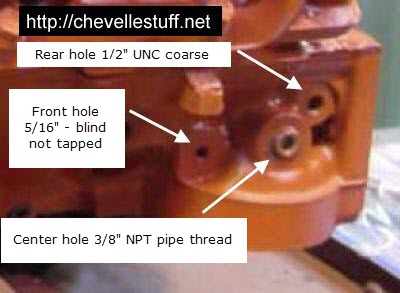
The 2-bolt main block has the 5/16" front hole that is not drilled
and tapped into the oil galley, the center hole is drilled and tapped
into the oil galley with a 3/8" pipe thread hole and the rear hole
is 1/2" UNC coarse that is not drilled and tapped into the oil
galley. The rear hole has a machined surface and is used to mount the
pivot ball for a manual transmission clutch release cross-shaft.
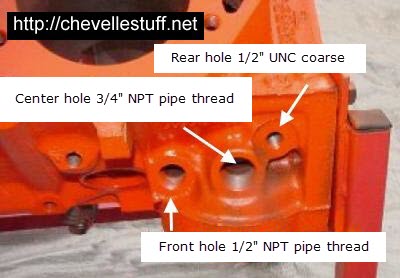
The 4-bolt main block has a 1/2" pipe thread front hole, the center
hole is drilled and tapped into the oil galley with a 3/4" pipe
thread and the rear hole is 1/2" UNC coarse that is not drilled
and tapped into the oil galley. The rear hole has a machined surface
and is used to mount the pivot ball for a manual transmission clutch
release cross-shaft.
Casting Clock
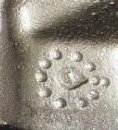
The Saginaw foundry casting clock is approximately 2-inches in diameter
and is usually found on the rear of the block by the casting number.
The clock has 10 dots representing an hour of a shift. The second dot
outside the circle indicates the start of a ten-hour shift. The Saginaw
foundry usually ran two ten-hour shifts, 7:00 A.M. to 4:00 P.M. and
4:00 P.M. to midnight. Parts cast at the beginning of the shift would
have the pointer pointing to the double-dot position as shown in the
photo. Every hour the pointer would be moved clockwise to indicate the
hour. The slot in the pointer indicates the shift. A flat, slotted head
indicates the first shift, the second shift has a round head in the
pointer. This pointer indicates this block was cast first hour of the
first shift, or 7:00 to 8:00 A.M.

Note the difference in the Tonawanda foundry casting clock. This clock
has 11 dots plus the number 12. The pointer indicates this block was
cast in the 8th hour of the shift.
Block Casting Numbers
The block's casting number is generally located on the driver side of the block at the rear where the bellhousing bolts to the block. It's generally thought that the letters "P" and "T" represent "Passenger" and "Truck" but there's no evidence of this as of yet.

1964-1965 327 block casting number 3782870.

1964-1966 283 block casting number 3849852.

1964/1965/1966 283 block casting number 3834810 casting date B 21 6.
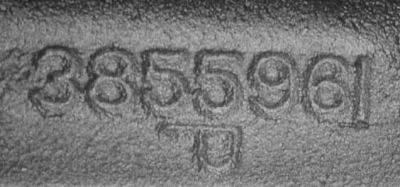
1966 396 block casting number 3855961.
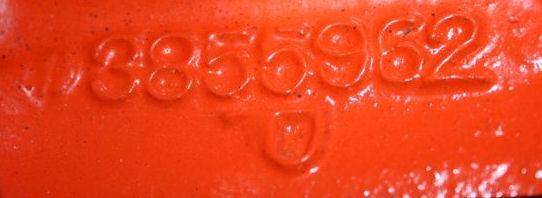
1965/1966 396 block casting number 3855962.

1967 327 block casting number 3892657.

1966/1967 396 block casting number 3902406.

1967/1968 396 block casting number 3916323.

This late 1967 396 engine is a 3916323 casting but retains the canister
type oil filter.
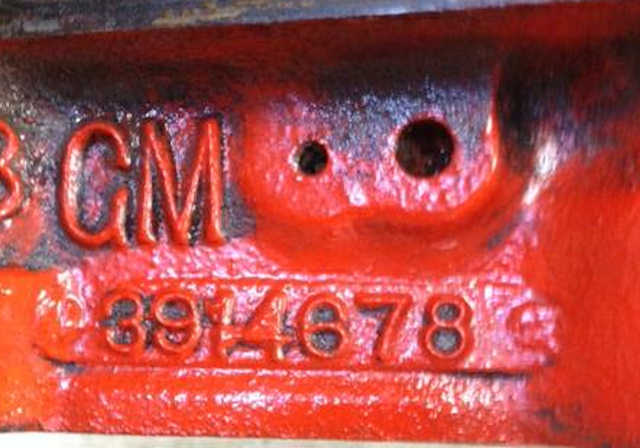
1968 327 block casting 3914678
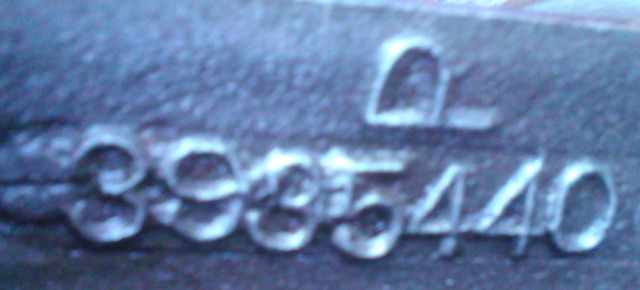
1968/1969 396 block casting 3936440.

Another 1968 396 block casting number 3916323 that's much different
from the example above.

1969 396/402 block casting number 3955272 (note "T" as opposed
to "P" in next photo)

1969 396/402 block casting number 3955272 (Note both the "T"
above and "P" here were found in Chevelles.)


Casting #3963512 with J 2 - 9 (October 2, 1969) casting date.


1969-1971 427/454 block casting number 3963512 with October 15 casting
date on bell housing area.
(10) This 3963512
block dated October 15, 1969 has casting date on bell housing flange
and is a warranty block.
Courtesy Todd Burke
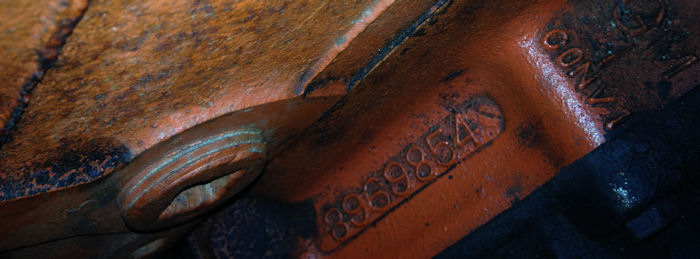
1969-1972 402 block casting number 3969854.
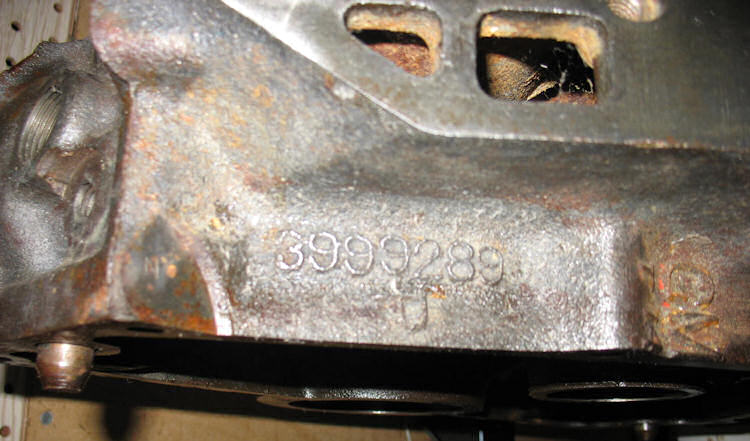
1972 block casting number 3999289

1972 402 block casting number 3999290.
Casting Dates

Note casting date of B24 70 on this Chevelle 350
block.
The block's casting date is either on the passenger side of the block at the rear where the bellhousing bolts to the block or on the passenger side of the block near the freeze plug and generally are in the format of a letter for the month, a one- or two-digit number for the day and a single digit number for the year.
It's reported that some early blocks have been found with three digits representing the month, day, and year. These early blocks may also have more than three digits depending on the month and day.

1968 396 casting date L 6 7 for December 6, 1967.
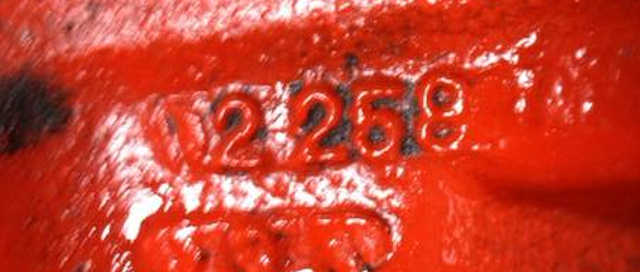
1968 327 casting date 2 25 8 for February 25, 1968. Note this date begins
with the number "2" instead of a letter.

1969 396 casting date H 9 8 for August 9, 1968
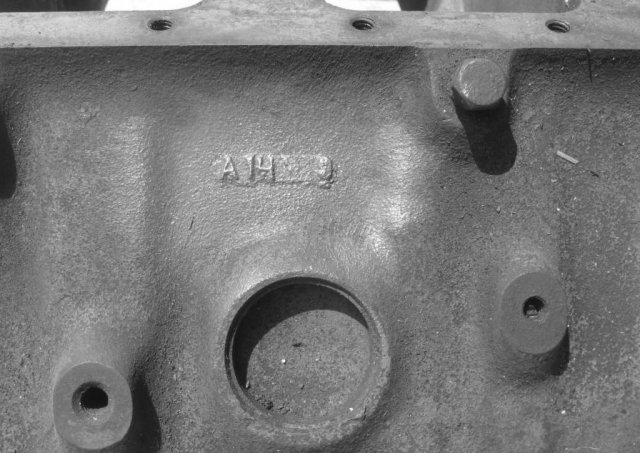
1969 396 casting date A 14 9 for January 14, 1969

1969 396 casting date C 14 9 for March 14, 1969 - note this casting
date is on the rear of the engine block next to the bellhousing.
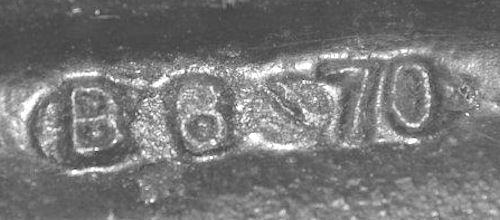
1970 396 casting date B 6 70 for February 6, 1970. Note 1970 has a 2-digit
year code.

1970 454 casting date of C 10 70 for March 10, 1970.
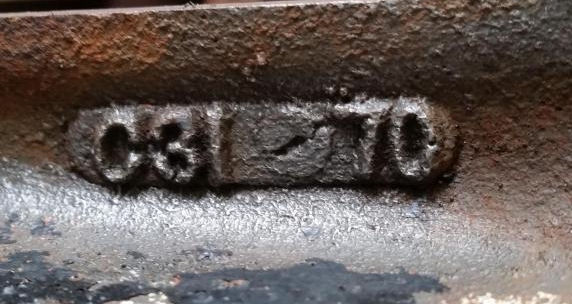
1970 454 casting date of C 31 70 for March 31, 1970.
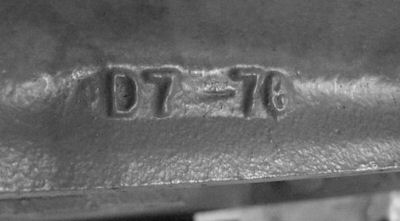
1970 396 casting date of D 7 70 for April 7, 1970.
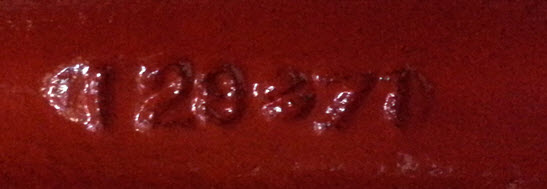
1972 402 casting date of I 20 71 for September 20, 1971


CE warranty block dated I 6 72 for September 6, 1972
Engine Bore and Stroke of 1964-1972 Chevelle Engines - Cubic inches = Bore x Bore x Stroke x .7854 x #cylinders
| Cubic Inches | Cylinder Bore | Crankshaft Stroke |
| 194 (L6) | 3.564 | 3.250 |
| 230 (L6) | 3.875 | 3.250 |
| 250 (L6) | 3.875 | 3.530 |
| 283 (V8) | 3.875 | 3.000 |
| 307 (V8) | 3.875 | 3.250 |
| 327 (V8) | 4.000 | 3.250 |
| 350 (V8) | 4.000 | 3.480 |
| 396 (V8) | 4.094 | 3.760 |
| 402 (V8) | 4.124 | 3.760 |
| 427 (V8) | 4.250 | 3.760 |
| 454 (V8) | 4.251 | 4.00 |

 Home
Home Decode
Decode Tech
Tech Tools
Tools Dale's Coins/CDs
Dale's Coins/CDs Contact
Contact Chevelle
of the Month
Chevelle
of the Month Things
For Sale
Things
For Sale Custom
Stickers
Custom
Stickers